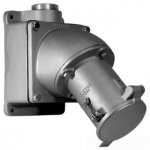We purchased a 60kW diesel generator (120/240V 3-phase delta) to provide emergency power for our storm water pumps; the generator will be trailer mounted. The service panel and the generator each have 200A OCPD/disconnects.
The manual transfer switch I've selected is a Winco/Square-D 200A 3-pole switch,
Catalog #DTU324NRB. This unit does not switch the neutral. So my understanding is that while the generator is connected to the transfer switch, then the generator is not considered a "separately derived system" and thus does not need its own GES. (However, I do need to ensure that the generator's neutral is not bonded to its ground.)
However, we will be making the connection from the generator to the pump house via a flexible cable and reverse service pin & sleeve plug/receptacle. Since this means the generator's neutral (and its phases) can be disconnected from the transfer switch, does this change the "separately derived system" status of the generator? There is no intention of operating the generator while it is not plugged into the transfer switch.
Also, what wire is typically used inside the receptacle mounting box to connect the pin & sleeve receptacle to the transfer switch. From photos, it seems that the mounting box doesn't have the depth to accommodate large gauge stranded THWN copper wire. Is it typical to use flexible wire inside these boxes?
The manual transfer switch I've selected is a Winco/Square-D 200A 3-pole switch,
Catalog #DTU324NRB. This unit does not switch the neutral. So my understanding is that while the generator is connected to the transfer switch, then the generator is not considered a "separately derived system" and thus does not need its own GES. (However, I do need to ensure that the generator's neutral is not bonded to its ground.)
However, we will be making the connection from the generator to the pump house via a flexible cable and reverse service pin & sleeve plug/receptacle. Since this means the generator's neutral (and its phases) can be disconnected from the transfer switch, does this change the "separately derived system" status of the generator? There is no intention of operating the generator while it is not plugged into the transfer switch.
Also, what wire is typically used inside the receptacle mounting box to connect the pin & sleeve receptacle to the transfer switch. From photos, it seems that the mounting box doesn't have the depth to accommodate large gauge stranded THWN copper wire. Is it typical to use flexible wire inside these boxes?


